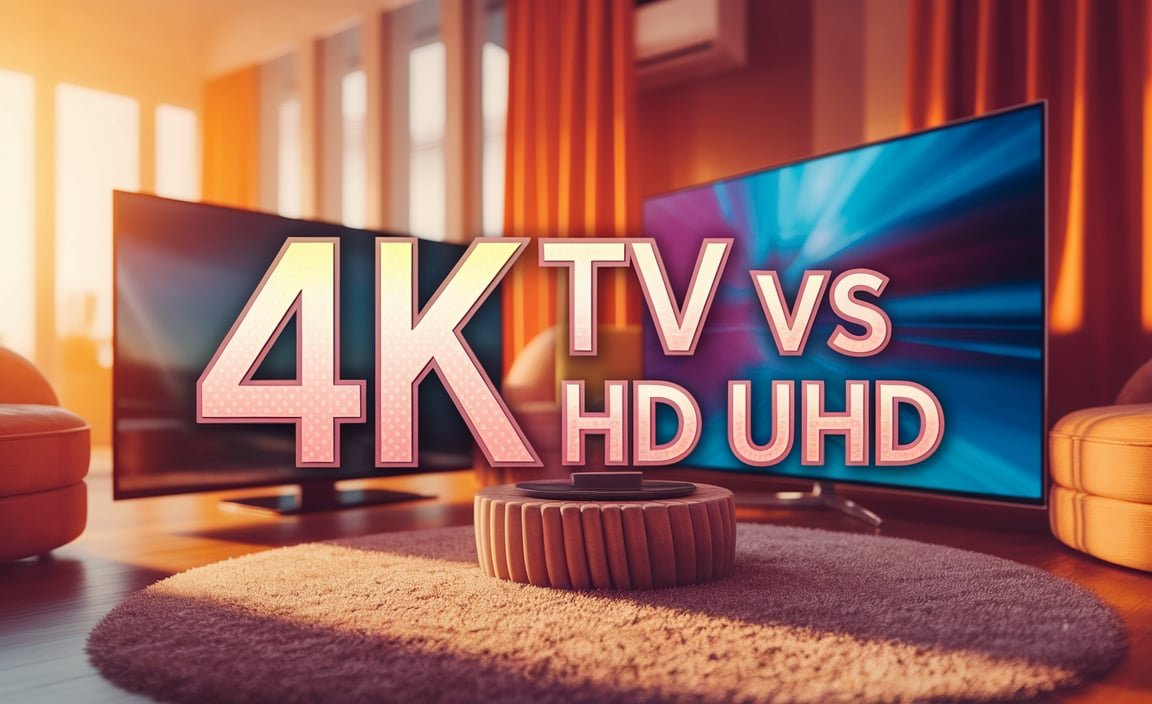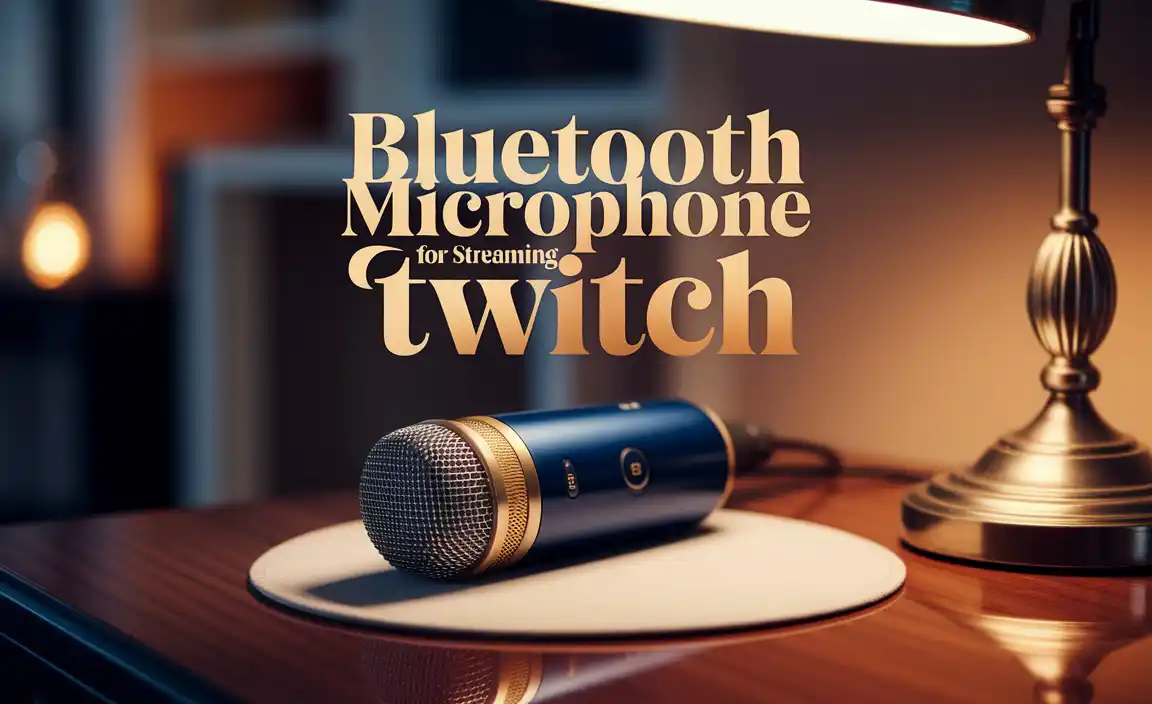Quick Summary
For streaming, both Mini LED and OLED offer stunning visuals, but they excel in different areas. OLED delivers perfect blacks and infinite contrast for movie nights, while Mini LED provides incredible brightness for well-lit rooms and HDR content, making it a versatile yet affordable choice. Choose OLED for ultimate cinematic immersion and Mini LED for vibrant, bright-room performance.
Choosing a new TV for streaming can feel like navigating a maze. You’ve heard buzzwords like “OLED” and “Mini LED,” and they sound fancy, but what do they actually mean for your streaming experience? Don’t worry, it’s not as complicated as it sounds! We’ll break down these two top-tier TV technologies so you can pick the perfect screen for your favorite shows and movies. Get ready to upgrade your binge-watching sessions without the guesswork.
Mini LED vs OLED Streaming: Which TV Tech is Right for You?
Welcome to the exciting world of modern TV displays! As you’re looking to upgrade your home entertainment setup, you’ve likely encountered two of the most talked-about display technologies: Mini LED and OLED. Both promise incredible picture quality, but they get there using different methods. Understanding these differences is key to picking the TV that will truly elevate your streaming experience, whether you’re diving into cinematic dramas, fast-paced sports, or vibrant animated films.
Think of it this way: both are fantastic, but they have unique strengths that cater to different viewing environments and preferences. We’re here to demystify Mini LED and OLED, helping you make an informed decision without getting lost in technical jargon. Let’s explore what makes each one special and which might be your perfect streaming partner.
Understanding the Basics: How TVs Create Pictures
Before we dive into the specifics of Mini LED and OLED, it’s helpful to have a basic understanding of how TV screens work. At their core, TVs display images by lighting up tiny dots called pixels. When you see a beautiful picture on your screen, it’s actually millions of these pixels working together. The magic happens in how these pixels are controlled and illuminated, and this is where Mini LED and OLED technologies diverge significantly.
Older TV technologies, like LCD (Liquid Crystal Display), relied on a backlight that glowed consistently behind the entire screen. This meant that even when displaying black, some light would still leak through, making blacks appear more like dark gray. Modern technologies aim to overcome this limitation for more lifelike images.
What is OLED Technology?
OLED stands for Organic Light-Emitting Diode. The revolutionary aspect of OLED is that each individual pixel on the screen generates its own light. This means that when a pixel needs to display black, it simply turns off completely. No light, no glow – just pure, absolute black.
This self-emissive nature is what gives OLED its signature benefit: perfect black levels and near-infinite contrast ratios. The difference between the brightest white and the darkest black on an OLED screen is incredibly vast, leading to a spectacular, lifelike image. When you watch a dark scene in a movie, you’ll notice details in the shadows that might be lost on other TV types.
Key Characteristics of OLED
- Perfect Black Levels: Because each pixel can turn off entirely, OLEDs achieve true blacks.
- Infinite Contrast Ratio: The difference between the brightest and darkest points is theoretically unlimited.
- Wide Viewing Angles: Colors and contrast remain consistent even when viewing from the side.
- Fast Response Times: Pixels can change states incredibly quickly, reducing motion blur – ideal for gaming and sports.
- Thin Panel Design: Without a separate backlight layer, OLED TVs can be exceptionally thin and sleek.
The Drawbacks of OLED
While OLED is incredible, it’s not without its potential downsides. The primary concern for some users is brightness. Because each pixel generates its own light, OLEDs generally can’t get as blindingly bright as some of the best Mini LED TVs. This can be a factor in very bright, sun-drenched rooms where screen reflections and glare can be an issue.
Another consideration, though less of a concern for most streamers today, is the potential for burn-in. This occurs when a static image is displayed for very long periods, potentially leaving a permanent faint outline on the screen. Modern OLED TVs have many built-in safeguards to prevent this, and for typical mixed content viewing (streaming shows, movies, playing games), it’s rarely a problem.
What is Mini LED Technology?
Mini LED is a more advanced iteration of traditional LED-backlit LCD TVs. Instead of a few large LEDs behind the screen, Mini LED TVs use thousands of tiny LEDs grouped into hundreds or even thousands of “dimming zones.” These smaller LEDs allow for much finer control over the brightness of different parts of the screen.
This advanced backlighting system is crucial. It enables Mini LED TVs to achieve significantly better contrast and black levels compared to standard LED TVs, getting closer to the performance of OLED. The key advantage of Mini LED, however, often lies in its potential for much higher peak brightness.
Key Characteristics of Mini LED
- High Peak Brightness: Mini LED TVs can reach much higher brightness levels than OLEDs, making them excellent for HDR content and bright rooms.
- Improved Black Levels: The local dimming zones significantly reduce light bleed, offering deeper blacks and better contrast than standard LED TVs.
- Vibrant Colors: High brightness enhances the vibrancy and impact of colors, especially in HDR.
- Less Susceptible to Burn-in: Unlike displays with self-emissive pixels, Mini LED technology is not prone to permanent image retention or burn-in.
- More Affordable Options: While high-end, Mini LED technology is often found in a wider range of price points than comparable OLEDs.
The Drawbacks of Mini LED
Despite their impressive advancements, Mini LED TVs still rely on a backlight. This means that achieving the perfect, absolute black of an OLED is more challenging. Even with thousands of dimming zones, there can still be a small amount of light bleed, sometimes referred to as “blooming” or “haloing,” around bright objects on a dark background.
The number and sophistication of the dimming zones can vary significantly between Mini LED models and brands. A TV with fewer dimming zones might not offer as much precise control over contrast as one with many more. Therefore, while “Mini LED” sounds impressive, the actual implementation matters.
Mini LED vs OLED Streaming: Direct Comparison
Now that we understand the core technologies, let’s put them head-to-head for your streaming needs. The choice often comes down to your viewing habits and environment.
Picture Quality: The Crucial Differences
When it comes to sheer visual impact, both technologies deliver. However, their strengths are different:
- Black Levels and Contrast: OLED wins here, hands down. Its ability to turn pixels completely off results in perfect blacks and an unmatched sense of depth. This is particularly noticeable in dark movie scenes or space documentaries.
- Brightness: Mini LED often takes the crown for peak brightness. This is a significant advantage in rooms with lots of natural light or when watching High Dynamic Range (HDR) content, where bright highlights really pop.
- Color Volume: While both offer excellent color, the higher brightness of Mini LEDs can make colors appear more saturated and vibrant, especially in HDR content.
- Motion Handling: Both technologies offer excellent motion handling. OLEDs have incredibly fast pixel response times, while Mini LEDs benefit from advanced processing to reduce blur. For fast-paced sports or action movies, both are superb, though OLED often has a slight edge in eliminating motion artifacts.
Viewing Experience: Room and Content Matters
Your viewing environment and the type of content you watch most are key factors:
- Dark Room Viewing (Movie Theaters, Media Rooms): For an immersive, cinematic experience, OLED is often preferred. The perfect blacks and infinite contrast create a depth and realism that’s hard to beat when the lights are down.
- Bright Room Viewing (Living Rooms with Windows): If your TV is in a room that gets a lot of ambient light, a brighter Mini LED TV can overpower reflections and maintain a punchy image. The high brightness also makes HDR content shine.
- HDR Content: Both technologies are fantastic for HDR. However, a brighter Mini LED TV can showcase the extreme highlights of HDR content more effectively, leading to a more impactful visual experience for those specific scenes.
- Gaming: Both are superb for gaming due to their fast response times and excellent contrast. OLED’s near-instantaneous pixel response can provide an edge in competitive gaming, while Mini LED’s brightness can be an advantage in well-lit gaming setups. It’s worth noting that response time is a critical factor for gamers, and many PC gamers are interested in the low response times offered by modern OLED displays.
Durability and Longevity
Both technologies are built to last for many years. As mentioned, the concern about OLED burn-in is largely mitigated by modern technology and typical usage patterns. Mini LED, being an evolution of LCD, has no inherent burn-in risk.
For longevity, both are excellent choices. The typical lifespan of both OLED and Mini LED panels far exceeds typical consumer replacement cycles. For a deeper dive into panel longevity and testing, resources like those found on Rtings.com’s TV longevity guide can offer more detailed insights into display panel lifespan and degradation.
Price and Value
Historically, OLED TVs have been positioned as premium products with premium price tags. While prices have come down, they still tend to be more expensive, especially for larger screen sizes.
Mini LED technology, while also featuring in high-end models, has become more accessible across a broader range of prices. You can often find excellent Mini LED TVs that offer a picture quality close to OLED, especially in brighter environments, at a more budget-friendly cost. This makes Mini LED a very compelling value proposition for many.
Key Differences at a Glance: Mini LED vs OLED Table
Here’s a handy table summarizing the main points to help you decide:
| Feature | OLED | Mini LED |
|---|---|---|
| Black Levels | Perfect (Pixels turn off) | Excellent (Very deep with local dimming) |
| Contrast Ratio | Infinite | Very High |
| Peak Brightness | Good to Very Good | Excellent to Extreme |
| Color Vibrancy | Excellent | Excellent (especially in HDR with high brightness) |
| Viewing Angles | Excellent | Good to Very Good (can vary by panel type/layers) |
| Motion Clarity | Excellent (fastest pixel response) | Excellent (advanced processing) |
| Burn-in Risk | Very Low (modern tech mitigates) | None |
| Panel Thickness | Extremely Thin | Thinner than standard LED, but thicker than OLED |
| Best For | Dark room viewing, ultimate cinematic contrast, gaming | Bright room viewing, impactful HDR, those concerned about burn-in, potentially better value |
| Price | Generally Higher | Wide Range, often more affordable options at similar perceived quality |
Making the Right Choice for Your Streaming Habits
So, how do you translate this information into a decision? Consider these questions:
- What time of day do you watch most? If it’s primarily at night or in a dedicated media room, OLED’s perfect blacks will impress. If you watch a lot during the day with lights on, Mini LED’s brightness is a big plus.
- How important are deep, inky blacks to you? For the ultimate cinematic contrast, OLED is the benchmark.
- Do you watch a lot of HDR content? While both are great, the higher peak brightness of Mini LEDs can make HDR highlights truly spectacular.
- What’s your budget? Mini LED often provides more bang for your buck, especially when you consider the top-tier brightness.
- Are you worried about burn-in? While rare for most users, if this is a persistent concern, Mini LED is the safer bet.
Who Should Choose OLED?
You might lean towards OLED if:
- You prioritize the absolute best picture quality for movies and cinematic content.
- You mostly watch in a dim or dark room.
- You’re a serious gamer who craves the fastest response times and perfect blacks.
- Budget is less of a concern, and you want the ultimate viewing experience.
Who Should Choose Mini LED?
You might lean towards Mini LED if:
- You watch TV in a bright, well-lit room.
- You want to experience the full impact of HDR content.
- You’re looking for excellent picture quality with great value for your money.
- You want peace of mind regarding potential screen burn-in.
- You’re a sports fan who values bright, clear motion.
The Future of TV Displays
The competition between display technologies like OLED and Mini LED is a win for consumers. Each innovation pushes the boundaries of what’s possible, leading to even better and more accessible TVs. Manufacturers are constantly refining both Mini LED and OLED, improving brightness, contrast, color accuracy, and efficiency.
We’re also seeing hybrid approaches and new technologies emerge, but for now, Mini LED and OLED represent the pinnacle of consumer TV display technology. Understanding their core differences is your best tool for making a choice that you’ll be happy with for years to come.
Frequently Asked Questions (FAQ)
Q1: Is OLED significantly better than Mini LED for streaming movies?
For dark room movie watching, OLED’s perfect blacks offer a superior contrast and depth that many consider unparalleled. However, high-end Mini LEDs are very close and can be better if your room is not completely dark.
Q2: Can Mini LED TVs prevent screen burn-in?
Yes, Mini LED technology is not susceptible to permanent image retention or burn-in, as it doesn’t use self-emissive pixels.
Q3: Which type of TV is better for HDR content?
Both are excellent for HDR. However, Mini LED TVs often achieve higher peak brightness, making HDR highlights (like explosions or lens flares) appear more dazzling and impactful.
Q4: Which TV technology is generally more affordable?
Mini LED technology tends to be more accessible across a wider range of price points, often offering a strong value proposition compared to OLED, especially for larger screen sizes.
Q5: Do I need a special setup for OLED TVs?
No, modern OLED TVs include many built-in features to prevent burn-in during normal mixed usage. You can stream, game, and watch TV without excessive worry.
Q6: What is “blooming” on a Mini LED TV?
Blooming, or haloing, is when light from a bright object on screen briefly leaks into the surrounding dark areas. It’s a characteristic of local dimming technologies like Mini LED, and its visibility can vary depending on the TV’s design and number of dimming zones.
Q7: Are viewing angles important for streaming?
Yes, if you often have people watching from different angles in the room. OLED TVs typically offer superior, consistent viewing angles where colors and contrast don’t degrade as much when viewed from the side.
Conclusion: Shine Bright or Go Deep?
Choosing between Mini LED and OLED for your streaming needs is about aligning the TV’s strengths with your viewing habits and environment. If you crave the ultimate in cinematic depth, perfect blacks, and watch primarily in controlled lighting, OLED is a phenomenal choice. Its pixel-level control delivers an image that can feel incredibly lifelike and immerse you completely in your content.
On the other hand, if your living room bathes in sunlight, you want your HDR content to truly pop with blinding highlights, or budget is a primary consideration, Mini LED offers incredible performance. Its advanced backlighting provides fantastic contrast and vibrant colors, all while delivering brightness that can conquer any lighting condition and offering complete peace of mind against burn-in.
Ultimately, you can’t go wrong with either of these cutting-edge technologies. By understanding what makes each one tick, you’re well-equipped to select the TV that will make every streaming session a true spectacle. Happy watching!







